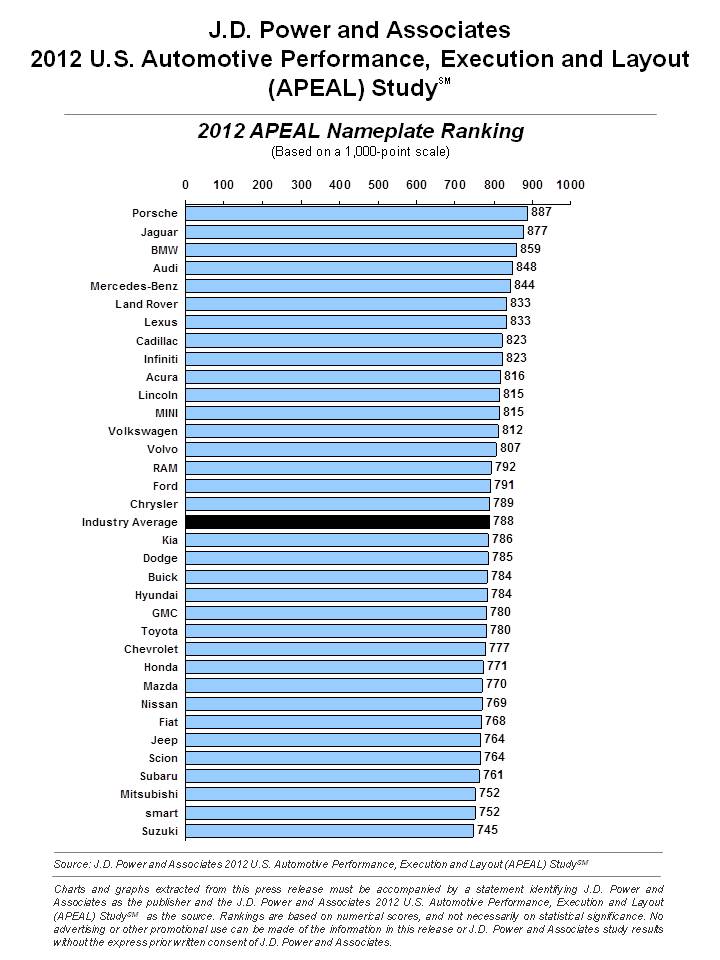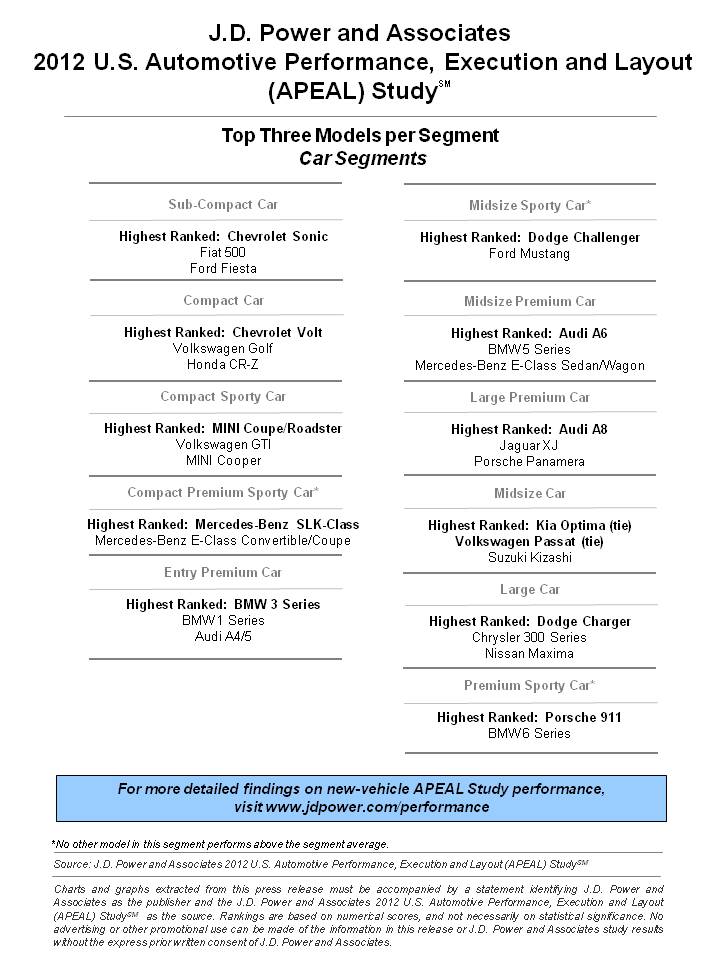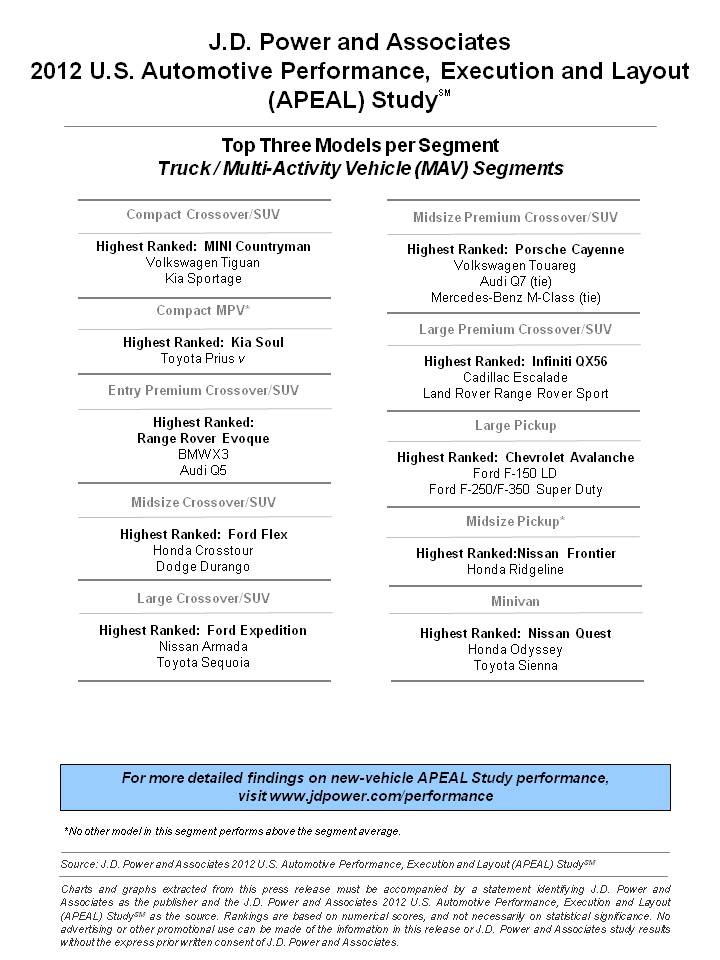As owners continue to shift toward smaller vehicles, they are finding that the ones they buy are often just as appealing as the larger vehicles they previously owned, according to the J.D. Power and Associates 2012 U.S. Automotive Performance, Execution and Layout (APEAL) StudySM released today. The study finds that 27 percent of new-vehicle buyers who replaced a vehicle downsized—meaning they purchased a new vehicle in a smaller segment than the vehicle they replaced. In contrast, only 13 percent of buyers "upsized," while 60 percent purchased a new vehicle in the same size segment as their previous vehicle.
"New-vehicle buyers who downsize are not making the sacrifice that they once were," said David Sargent, vice president of global automotive at J.D. Power and Associates. "Automakers are heavily focused on providing the U.S. market with appealing smaller models, and buyers may be surprised at just how good some of them are."
The vehicles currently being traded in for new ones are approximately six years old, on average, according to data from J.D. Power's Power Information Network® (PIN). During that period of time, vehicle appeal overall has significantly increased, and today's smaller vehicles are, in many cases, more appealing than the larger vehicles being replaced. In 2012, the average APEAL Study score for vehicles in the compact/sub-compact segment is 765 points (on a 1,000-point scale), which is the same as the average for midsize vehicles in the study in 2008. Similarly, in 2012, the average APEAL Study score for vehicles in the midsize premium segment is 844, the same as the average for large premium vehicles in 2008.

"For many years, almost twice as many vehicle owners have downsized, compared with those who have upsized," said Sargent. "Although larger models continue to attain higher APEAL Study scores than smaller models, as they typically provide higher performance, have more pleasing styling, are more comfortable and include more features, owners who downsize find that today's compact models are not the 'econoboxes' that they may have once feared. For example, most compact vehicles are more substantial than in the past and perform much better on the road. They also have many of the features and appointments that were previously found only on larger models. Vehicle owners who downsize are often finding that they are actually upgrading when they buy a new vehicle."
The downsizing trend also has an impact on owner satisfaction with the fuel economy of their new vehicle. While overall vehicle appeal continues to improve, increasing seven points year over year, the greatest improvement is in fuel economy. Furthermore, 47 percent of owners say gas mileage was one of the most important factors in choosing their new vehicle, up from 40 percent in 2011.
Model-Level and Nameplate Rankings
Chevrolet receives the highest number of segment awards of all brands included in the study for the Avalanche, Sonic and Volt models.
Seven brands each receive two model awards: Audi (for the A6 and A8); Dodge (Challenger and Charger); Ford (Expedition and Flex); Kia (Optima in a tie and Soul); MINI (Countryman and Coupe/Roadster); Nissan (Frontier and Quest); and Porsche (Cayenne and 911). The Audi A8 achieves the highest APEAL Study score of any model in the industry in 2012.
Also receiving awards are the BMW 3 Series; Infiniti QX56, Range Rover Evoque; Mercedes-Benz SLK-Class; and Volkswagen Passat in a tie.
Porsche is the highest-ranking nameplate for an eighth consecutive year. Dodge, Jaguar and Ram achieve the greatest year-over-year improvements, increasing scores by 21, 20 and 19 points, respectively.
J.D. Power offers the following tips to consumers when purchasing a new vehicle:
- Have realistic expectations about the fuel economy of your vehicle, and remember that the city/highway/combined mileage ranges listed on the window sticker are merely estimates provided by the EPA. Your actual miles per gallon will vary due to many factors, including driving and weather conditions, driving style, tire inflation and the overall condition of your vehicle.
- Know the type of fuel your prospective new vehicle requires, including premium unleaded or diesel, and take that into account when budgeting for it.
- Before you buy, ask your salesperson to demonstrate all of the audio/entertainment/navigation features on the vehicle. Also, have them assist you in connecting your mobile device or portable audio player to the vehicle's communication system or audio interface in order to test for a good hands-free connection and to make sure the system recognizes your commands.
- Although exterior styling is the highest-scoring category in the 2012 APEAL Study and often the most significant purchase reason for many buyers, consider all aspects of a vehicle to ensure that in addition to looking good to you, it also meets your needs. Some vehicles that look good may have design-related issues, such as being hard to see out of, or may not offer the cargo space you desire.
The APEAL Study examines how gratifying a new vehicle is to own and drive, based on owner evaluations of more than 80 vehicle attributes. The 2012 APEAL Study is based on responses gathered between February and May 2012 from more than 74,000 purchasers and lessees of new 2012 model-year cars and light trucks who were surveyed after the first 90 days of ownership. The APEAL Study complements the Initial Quality Study (IQS), which focuses on problems experienced by owners during the first 90 days of ownership.

